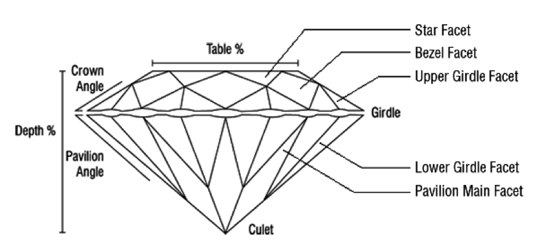Many people get it wrong when talking about the cut of the diamond. Some think it refers to its shape, but actually it refers to the parts that integrate it and the qualities that define its form. In this article we explain the most important details you can't miss about the cut of the diamond.
A beautiful diamond that sparkles with an astonishing light that enters and travels through it, it's all about its fine cut. This sparkle shows off three effects at once: the brilliance, the fire and the scintillation. When the white reflections of light cross all the way from the surface to the inner part of the stone, it causes the brilliance. When you detect colored flashes, you are looking at the fire; and whenever there is movement showing off light flashes, you are appreciating the brilliance.
In order to reach the three effects at the same time, the cut must be perfect. But first we need to understand the parts that form the body of the diamond and its variations. The diamond body is divided in: crown, girdle and pavilion.
- CROWN: It is the upper part of the diamond where you can see the table and its facets (bezel, star and upper griddle).
- GIRDLE: It is the line that connects the crown with the pavilion and works as the setting edge. Usually, the girdle outline doesn't affect the aspect of the round brilliant unless it is very irregular. We recommend to avoid extremely thick or thin girdles.
- PAVILION: It is the lower part of the stone and it has its own facets (the lower girdle, the pavilion and the culet). The culet is the flat facet at the bottom.

TABLE AND DEPTH. For round brilliants we recommend a table between 52%-60% and a depth between 58%-63.5%.
It is important to know that the size of the diamond does not influence the performance of the light but the wrong distribution of its proportions can lower its brilliance. For example, a stone that is too shallow or too deep can loose its sparkle or lack of light. The goal is to find a diamond with perfect symmetry between the top and the bottom for it to show a great light performance. Here are your cut options:

|
Diamond cuts are classified in brilliant, step and mixed cuts. The round one is the only diamond with the brilliant cut due to its 58 facets (57 if it has a culet). Stones with facets running parallel to the girdle are the step ones like the Baguette, Asscher, and the Emerald; and the diamonds with characteristics from brilliant and step cuts are the Princess, Cushion and Radiant; classified as mixed cut diamonds. To learn more about the diamond shapes click here.
Cut not only refers to the variation between shapes, its symmetry, or its proportions; it is also about the final measurement that the diamond has. For example one cushion cut diamond can be a perfect square or a defined rectangular.
In Dídiamant we offer all types of diamonds among different cuts, shapes, colors, clarity, and carats; but when it comes to the cut we always suggest our clients to look for an Excellent or a Very Good cut. Sometimes, if you are lucky enough, you can find attractive options between Good cuts, but it is hard to find one with a breathtaking sparkle. Likewise, this could be an option when you are willing to sacrifice cut in order to increase the carats of your diamond, choose a better color or select the purest clarity.
Now that you know all about the cut, it is your turn to decide what cut you want your diamond to have, just keep in mind that one of the most important characteristics of a diamond is its sparkle, its light, its brilliance; which is directly influenced by the cut. So, choose wisely!
If you have any doubts or need some extra help contact our experts!
We would like to know your opinion about our article. Was it useful for you? Leave us your thoughts.
 The best quality at the best price
The best quality at the best price 